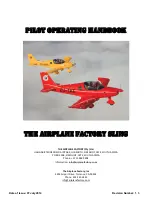
Owners Manu
al
XIX FORM 3
Asymmetric stalls and
flat spins
An asymmetric stall occurs if you are flying close to
minimum speed and pull down too much on one
side or if you brake very quickly on one side when
you are in level flight with no brakes e.g. to avoid a
collision.
Immediately release both brakes as soon as you
notice the braked part of the glider starting to ro-
tate backwards and beginning to spin. The glider
will then immediately regain normal flight. Use the
brakes to control the glider if it surges.
Be careful!
Try out this manoeuvre carefully, be-
cause at more than 90° it becomes a flat spin .
WARNING!
We advise you not to carry out the following
manoeuvres intentionally.
Flat spin
This will not occur if the
FORM 3
is handled cor-
rectly. A flat spin occurs if you pull down one brake
continually and stall that side of the glider. When
recovering from an asymmetric stall, the glider will
rotate quickly around its axis.
If this happens, immediately release both brakes
(hands up!). Use the brakes for control if the glider
then surges forward.
You can also stop rotation with both brakes and re-
lease the full stall symmetrically.
Full stall
This will not occur if the
FORM 3
is handled cor-
rectly. It only happens if both brakes are applied
fully and held for several seconds. The glider will
then quickly deflate and suddenly stop flying. It is
very important in this situation to remain calm.
Don’t release the brakes suddenly because you will
also swing backwards while the glider starts to fly
forwards. You must not release the brakes until the
glider has stabilised above you. Only then should
you release the brakes evenly and slowly (count
21-22-23 as you do this). Use the brakes to control
the glider when you feel it swing forward and start
flying again.
Full-Stall
12










































